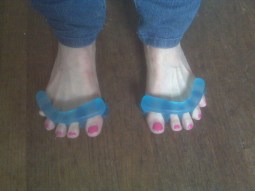 Overview
Overview
Hammer Toe affects both joints of a toe, causing the toe to bend upwards at the proximal joint (the joint closest to the foot) and down at the distal joint (the one farthest away from the foot). The resulting unnatural bend is often compared to an upside down “V” and also to a hammer or a claw (The condition is sometimes referred to as clawtoe or clawfoot). A similar condition, in which the first joint of a toe simply bends downward, is called mallet toe. Since the arched bending of hammertoe often causes the toe to rub against the top of the shoe’s toe box and against the sole, painful corns and calluses develop on the toes. Hammertoe can also be a result of squeezing within a too-small or ill-fitting shoe or wearing high heels that jam your toes into a tight toe box inside your shoe, arthritis, trauma and muscle and nerve damage from diseases such as diabetes. Probably because of the tight-shoe and high-heel shoe factors, hammertoe tends to occur far more often in women than in men.
Causes
Hammer toes can be due to a number of things. Several factors are known to increase the risk of developing hammer toes. Some people are just structurally prone to develop hammer toes (hereditary) tight footwear is an important factor in the cause of hammer toes as well as providing the pressure that causes the symptoms, weaker small muscles in the foot may also play a role.
 Symptoms
Symptoms
For some people, a hammer toe is nothing more than an unsightly deformity that detracts from the appearance of the foot. However, discomfort may develop if a corn or callus develops on the end or top of the toe. If pressure and friction continue on the end or top of the toe, a painful ulcer may develop. Discomfort or pain can lead to difficulty walking.
Diagnosis
First push up on the bottom of the metatarsal head associated with the affected toe and see if the toe straightens out. If it does, then an orthotic could correct the problem, usually with a metatarsal pad. If the toe does not straighten out when the metatarsal head is pushed up, then that indicates that contracture in the capsule and ligaments (capsule contracts because the joint was in the wrong position for too long) of the MTP joint has set in and surgery is required. Orthotics are generally required post-surgically.
Non Surgical Treatment
Conservative treatment is limited to accommodation, not correction, of the deformity, though some patients find the relief they can get from these options to be more than enough to put off or even avoid surgery. These include better Footwear. Shoe gear with a wider toe box and higher volume causes less friction to the toes. Toe Braces and Strapping. Some toe braces and strapping techniques take some pressure off the toes during gait. Custom molded orthotics can redistribute the forces through the tendons that control the toe, lessening the pain and extent of the deformity.The calluses on the toe and the ball of the foot can be shaved occasionally to reduce some pain and pressure, although they will return due to the constant deformity.
Surgical Treatment
he basis for hammer toe surgery most often involves removing s portion of bone within the toe, to reduce the joint contracture. Depending on the direction the toe is deviated, soft tissue procedures may be necessary along with pinning the toe with a surgical wire.
 Prevention
Prevention
As you get older, feet get bigger. Get your feet measured every time you buy shoes. Don’t go by shoe sizes. Shoe sizes vary among manufacturers; a shoe is the right size only when it fits comfortably. The ball of your foot should fit into the widest part of the shoe. A shoe should be sturdy such that it only bends in the ball of the foot, exactly where your big toes bend. Any shoe that can be bent anywhere along the sole or twisted side to side is generally too flimsy.